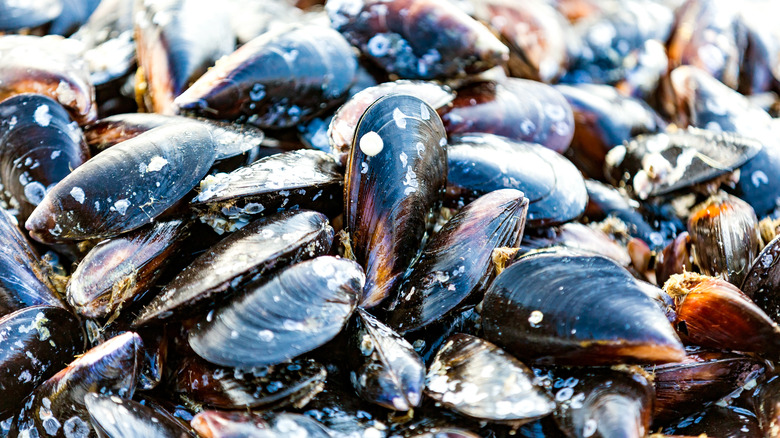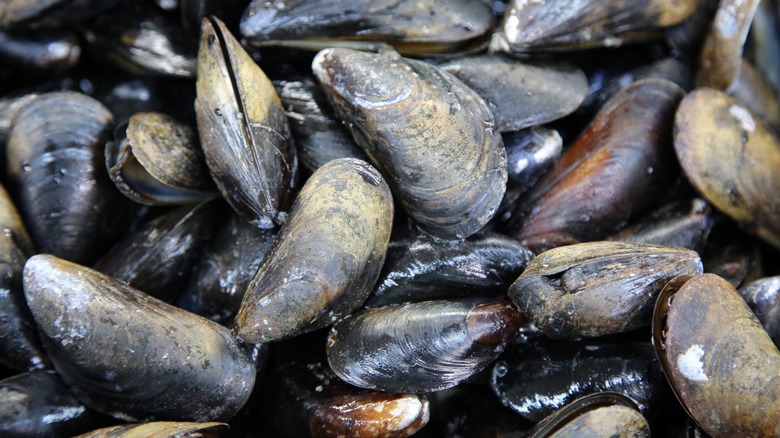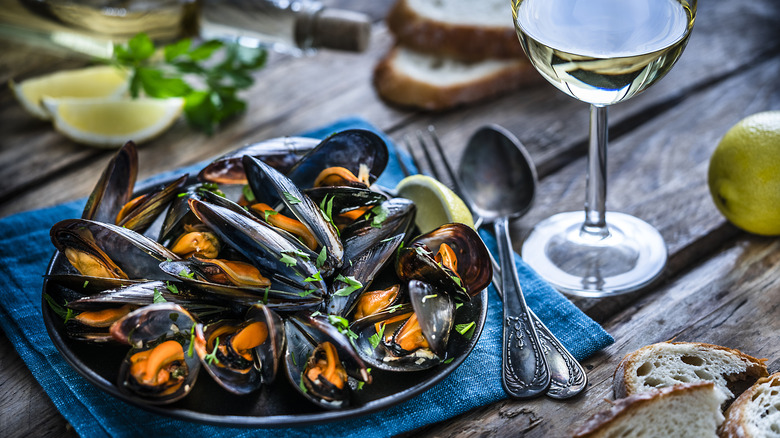How To Clean Mussels And Weed Out The Dead Ones
From cleaning and scrubbing to debearding, preparing mussels at home may seem like a daunting process. No, debearding mussels doesn't involve shaving them. But a mussel's so-called "beard" — a collection of sticky, fibrous byssus threads that assist these bivalve mollusks in anchoring themselves to their seabed environments — likely accounts for the trepidation among those preparing these delicious seafood delicacies at home for the first time. The idea of removing a beard just seems like it should be hard work.
It doesn't help, of course, that cleaning mussels often requires weeding out a few that are dead. If cleaning the beards sounded difficult, this aspect of the preparation process may seem downright creepy. In reality, neither debearding nor removing dead mussels is difficult or unpleasant at all. For starters, many mussels sold these days are farmed rather than wild, and have already been debearded by the time you buy them.
As to removing dead mussels, it should be noted that they will all be dead after you cook them — but they must be alive before cooking, for reasons that have to do with both taste and safety. You'll be able to identify the dead mussels from the live ones by their shells. The first step when it comes to preparing mussels, however, is to thoroughly clean them using a colander and a brush.
How to clean mussels and identify the dead ones
A colander is a helpful tool for cleaning mussels in the sink. Just remember that after rinsing the mussels off with water, it's also advisable to give them a good scrub with a mussel cleaning brush. This likely won't remove the mussels' beards, if there are any, but it should remove any other unwanted debris.
Debearding can be accomplished while the mussels are still in the sink. These fibrous threads are easy to spot, and are typically pretty easy to remove, as they can usually be pulled out by hand. Using two fingers is the best method for removing the beard. Simply grip the clump of threads and pull it towards the shell's hinge — meaning, the side that doesn't open. It should come out this way. If not, the threads will get cut by the hinge anyway, and you can scrape off any remnants with a knife.
As to culling dead mussels, this too can be done while the mussels are in a colander in the sink. Like bearded mussels, dead ones are easy to spot. Dead mussels' shells will already be gaping, or slightly open — something that normally doesn't happen prior to cooking a live mussel. While this gaping means the mussels are probably dead, don't automatically throw them away without testing them first. Give them a squeeze, or rap them against a hard surface. If the shell closes up, they're still alive, and ready for cooking.
Tips for buying and preparing mussels
Mussels are actually quite easy to clean, as those are the only three steps required in the preparation process: rinsing them thoroughly, debearding them by removing their fibrous threads, and culling the dead ones. All of these steps can be accomplished in your sink within the space of a few minutes.
A few helpful shopping tips can ensure that cooking your mussels is just as easy. There are dozens of ways to prepare tasty mussels, of course, from Italian specialties that pair the mollusks with pasta, to steamed mussels in white wine sauce, and myriad other options. However, the best way to ensure your dish turns out delicious is to buy the freshest available mussels, and to inspect them before purchase.
For instance, if you check to confirm that all the mussels' shells are closed before you buy them, then you won't have to throw any away. Not only does this save money, it also saves a step during cleaning. Just like a gaping shell could signify a dead mussel, dull-looking shells could be a sign of dead mussels, too. Pick mussels with the shiniest shells, and check to see if they have a harvest date attached via mesh packaging. Other tips to ensure freshness include verifying that you're buying mussels during their peak season (October to March), and that they've been stored over ice at your seafood market of choice.



